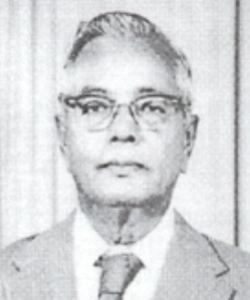Died 1981 | Religion Hindu Name B. Lakshman Succeeded by A. D. Patel | |
 | ||
Profession Businessman, Trade Unionist, Editor | ||
Brahma Dass Lakshman (1900 – 1981) was an Indo-Fijian politician, union leader and businessman, who had a considerable influence on Fiji’s sugar industry.
Contents
- Education and teaching career
- First election to Legislative Council
- Member of Kisan Sangh
- Second election win
- Trade unionist
- References
Education and teaching career
B.D. Lakshman graduated from Banaras Hindu University with a B.A. degree. In India, he was reputed to have taken part in the independence struggle with Gandhi. On his return to Fiji he started teaching at Gurukul Primary School in Saweni, Lautoka. In 1939, after some differences with the school committee he left the school and moved into Lautoka town and opened a night school where he taught adult men.
First election to Legislative Council
While in Lautoka he met leaders of the Kisan Sangh and offered his services to the sugar cane farmers’ union. He worked closely with the Kisan Sangh leadership, and when he expressed a desire to contest the 1940 Legislative Council election, he had no problem in obtaining endorsement from the Kisan Sangh, as the sitting member, Chattur Singh, had lost its confidence. B.D. Lakshman was also articulate and well educated. He stood for the North West Indian Division against Sadanand Maharaj, also a member of the Kisan Sangh, and won easily.
Member of Kisan Sangh
From 1940 to 1943, B.D. Lakshman represented the Kisan Sangh in negotiations with the Colonial Sugar Refining Company (Fiji) and in numerous discussions with the Government. He was also a key advisor to Ayodhya Prasad during the 1943 cane strike as the Kisan Sangh and Maha Sangh vied to support from the farmers. When the Kisan Sangh split into left and right wings he allied himself with the right wing led by Ayodhya Prasad but had secret meetings with members of the left wing. The badly split Kisan Sangh could not help him retain his seat in the 1944 Legislative Council election, when the candidate supported by the left wing of the Kisan Sangh and Maha Sangh, A. D. Patel easily defeated B.D. Lakshamn by 1841 votes to 554.
In 1953, differences arose between Ayodhya Prasad and B.D. Lakshman, who was now the Vice President of the Kisan Sangh, regarding payment to the Fijian landowners to obtain land to construct a building for the Kisan Sangh. Lakshman was expelled from the Kisan Sangh and subsequently involved himself with organising the sugar mill workers.
Second election win
In the 1956 Legislative Council election, B.D. Lakshman stood against Ayodhya Prasad but managed to get a mere 109 votes. His fortunes improved, when in 1958 he was elected into the Lautoka Town Council with the support of the local ratepayers association.
After the departure of Sidiq Koya from the Central Committee of the Kisan Sangh, Muslim supporters of the Kisan Sangh were alienated, and in the 1959 Legislative Council election supported B.D. Lakshamn to defeat Ayodhya Prasad and regain his old seat. He held his Legislative Council seat until the next election in 1963. He put up his name for a number of other elections but did not launch a serious campaign and remained out of politics for most of the rest of his life.
Trade unionist
Lakshman became the President of the Fiji Industrial Workers Congress following the death of Ami Chandra and was responsible for the gold mine workers strike of June 1955. In the negotiations for the 1960 cane contract B.D. Lakshman represented the mill workers.
